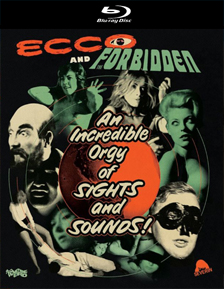Ecco and The Forbidden (Blu-ray Review)

Director
Gianni Proia/Benjamin Andrews/Lee FrostRelease Date(s)
1963/1966 (January 29, 2019)Studio(s)
Julia Film/Cresa Roma/LCR Films/Dear International/Something Weird (Severin Films)- Film/Program Grade: C
- Video Grade: C
- Audio Grade: C
- Extras Grade: C
Review
Long before the days of Youtube, if you wanted to experience the sights and sounds of people and places that were outside of regular entertainment channels, your options were limited to magazines, books, and occasionally, documentaries. Two selections of the latter items are presented here on Blu-ray for the fist time: Ecco and The Forbidden.
According to George Sanders, Ecco means to “Look, witness, observe, and behold.” He takes us on a narrated and somewhat fractured tour of various areas of the world, revealing many unusual practices of people from different nations and backgrounds. Highlights include German fencing amongst young men, Mardi Gras taking place in Rio, a secret Satanic ritual, graphic footage of men hunting whales, a Grand-Guignol theater performance, the nightlife activities of teenagers in Stockholm, blindfolded buttocks-touching, sliding sharp implements through various body parts with no apparent pain, mass reindeer herding, and much more. While some of it is fairly tame due to decades of exposure to many of the same or similar events, some of it is still quite offensive and gruesome. In other words, the squeamish and easily disgusted need not apply.
In The Forbidden, we primarily witness moments of the erotic and unlawful variety, such as floating strip clubs, Swiss sex rituals, Parisian dancers, virgin strippers, a faithless husband and his vengeful wife, erotic nightclub acts in Brussels, teenage protests on the Sunset Strip, Nazi strippers, and much more. The footage presented here is more of an attack on so-called perversion rather than a neutral exploration like its predecessor, meaning that the narrator makes repeated judgments as we see the various activities taking place. For those of the delicate persuasion, only one instance of bloodletting occurs in one of the film’s re-enactments.
Ecco comes sourced from a 4K scan of an internegative element. Like many of Severin Films’ releases, it’s a “warts and all” presentation, containing all of the leftover damage, such as scratches, speckling, tears, staining, and tape splices between shots. However, everything appears natural and organic, as if one dug an old print out of their attic. The color palette is varied due to the condition of the element that’s been used, but there’s no bleeding or major wash-outs. Everything is bright and subjects are easy to identify, but the contrast is boosted in certain areas, leaving black areas a blue-ish grey.
The Forbidden comes sourced from a transfer of what’s touted to be the only 35mm theatrical print left in existence. This time around, it’s a mix of color and black and white footage, cut together rather crudely. On the other hand, the presentation is more solid than its predecessor. Despite their unevenness, there are more obvious grain levels on display. However, colors tend to be completely washed out and flat most of the time, almost on the verge of monochrome, while others exemplify an overall sepia toned appearance. The black and white footage is often soft with contrast and gradation issues. Like Ecco, there’s also plenty of damage leftover, including scratches, speckling, and changeover cues.
The audio for both films is presented on English 2.0 mono DTS-HD tracks, and like their video counterparts, contain apparent leftover damage, including occasional dropouts, hiss, and crackle. The narrators are always heard clearly, but as per the original presentations, footage is not always synced with the sound, making it more of a collage at times. As such, there’s nothing really worthy of major complaint. Subtitles are also included in English SDH.
Extras include a full frame trailer for Ecco in HD; I Want More, a video-sourced 33-minute short film (bearing the Something Weird Video acronym watermark) containing much of the same kind of material as the two documentaries, particularly of The Forbidden variety; and The Bandit: Producer David Goldstein Remembers Bob Cresse, a 16-minute interview discussing the various types of films made by Cresse during his career.
Folks familiar with James A. Fitzpatrick’s Traveltalks shorts, but also open-minded to things outside of normal consumption, are bound to find something of interest in both Ecco and The Forbidden. Not only are they snapshots of a time and place, but also a window into an era before the internet would make them mostly obsolete. Severin Films’ double feature package brings them to high definition with a dash of sleaze and a heavy dose of conservation.
– Tim Salmons

